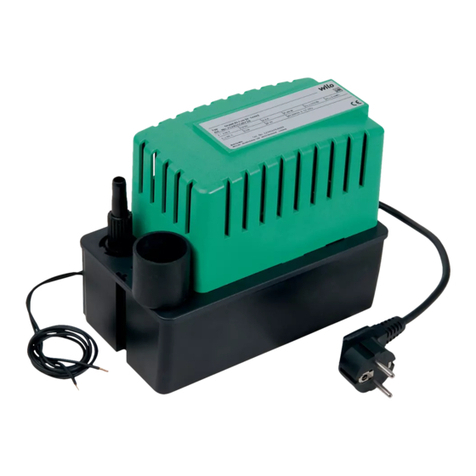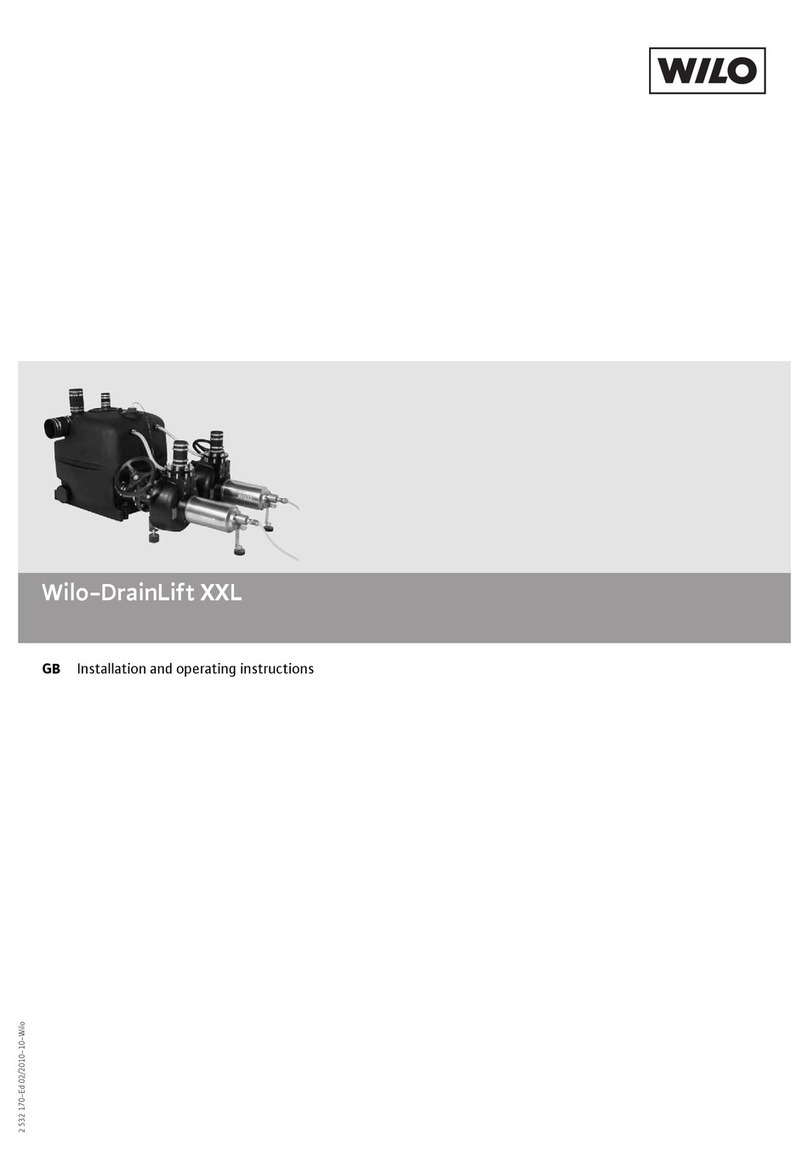DEUTSCH
4
2.2 Personalqualifikation
Das Personal für die Montage muß die entspre-
chende Qualifikation für diese Arbeiten aufweisen.
2.3 Gefahren bei Nichtbeachtung der
Sicherheitshinweise
Die Nichtbeachtung der Sicherheitshinweise kann
eine Gefährdung für Personen und Anlage zur
Folge haben. Die Nichtbeachtung der Sicher-
heitshinweise kann zum Verlust jeglicher Scha-
denersatzansprüche führen.
Im einzelnen kann Nichtbeachtung beispielsweise
folgende Gefährdungen nach sich ziehen:
– Versagen wichtiger Funktionen der Anlage,
– Gefährdungen von Personen durch elektrische,
Infektionen auslösende und mechanische Ein-
wirkungen,
– Gefährdungen von Personen und Umwelt durch
Nichtbeachtung von Hygienevorschriften für den
Umgang mit Infektionen auslösenden Medien.
2.4 Sicherheitshinweise für den Betreiber
Die bestehenden Vorschriften zur Unfallverhütung
sind zu beachten.
Gefährdungen durch elektrische Energie sind aus-
zuschließen. Vorschriften des VDE und der ört-
lichen Energieversorgungsunternehmen beachten.
2.5 Sicherheitshinweise für Inspektions- und
Montagearbeiten
Der Betreiber hat dafür zu sorgen, daß alle
Inspektions- und Montagearbeiten von autorisier-
tem und qualifiziertem Fachpersonal ausgeführt
werden, das sich durch eingehendes Studium der
Betriebsanleitung ausreichend informiert hat.
Grundsätzlich dürfen Arbeiten an der Anlage nur im
Stillstand durchgeführt werden.
2.6 Eigenmächtiger Umbau und
Ersatzteilherstellung
Veränderungen der Anlage sind nur nach Ab-
sprache mit dem Hersteller zulässig. Original-
ersatzteile und vom Hersteller autorisiertes
Zubehör dienen der Sicherheit. Die Verwendung
anderer Teile kann die Haftung für die daraus ent-
stehenden Folgen aufheben.
2.7 Unzulässige Betriebsweisen
Die Betriebssicherheit der gelieferten Anlage ist nur
bei bestimmungsmäßiger Verwendung entspre-
chend Abschnitt 1 der Betriebsanleitung gewähr-
leistet. Die im Katalog/Datenblatt angegebenen
Grenzwerte dürfen auf keinen Fall über- oder
unterschritten werden.
3 Transport und
Zwischenlagerung
– Beim Transport ist darauf zu achten, daß die
Anlage keinen Stoßbelastungen ausgesetzt wird.
– Die Anlage ist trocken und frostsicher zu lagern.
4 Beschreibung des Erzeugnisses
4.1 Beschreibung der Anlage
Die automatisch arbeitende Schmutzwasser-
Hebeanlage (Bild 1) besteht aus einem gas- und
wasserdichten Sammeltank aus Kunststoff, der auf
dem Boden (möglichst tief), z.B. unter einem
Waschbecken aufgestellt wird.
Die Anschlüsse für die Entwässerungsstellen (Bild
3, Pos.1/2) sowie für die Druckleitung (Bild 3, Pos.3)
befinden sich auf der Rückseite des Behälters. Der
hinter der Anlage verfügbare Platz ermöglicht eine
einfache Rohrführung. Dadurch lassen sich die
Zuläufe und die Druckleitung von beiden Seiten an-
schließen. Bei mehr als 2 Entwässerungsstellen ist
der Anschluß durch Verzweigung der Zulaufleitung
zu erreichen.
Es ist darauf zu achten, daß nicht aus allen
Entwässerungsstellen gleichzeitig Schmutzwasser
zuläuft.
Die im Behälter eingebaute Pumpe (Bild 1, Pos.1,
Bild 5) taucht bei gefülltem Behälter in das
Abwasser. Der Motor ist wasserdicht gekapselt. Die
Motorwelle ist zweifach gegen den Pumpenraum
abgedichtet.
Die Motorwicklung ist mit einer Überlastsicherung
geschützt, die den Motor bei übermäßiger Be-
anspruchung automatisch abschaltet und nach
Abkühlung automatisch wieder einschaltet.
Der eingebaute Staudruckschalter (Bild 1, Pos.4)
schaltet die Anlage niveauabhängig ein und aus.
Die Be- und Entlüftung des Behälters erfolgt durch
den in der Anlage integrierten Aktivkohlefilter (Bild
1, Pos.5) direkt in den Aufstellungsraum oder über
eine separat anzuschließende Entlüftungsleitung
über Dach. Um zu verhindern, daß bei einem Ausfall
der Pumpe und steigendem Flüssigkeitsstand der
Sammeltank durch den Aktivkohlefilter überläuft,
ist eine zusätzliche Rückschlagklappe (Bild 1,
Pos.6) eingebaut. Der Abflußanschluß enthält
ebenfalls eine Rückschlagklappe (Bild 1, Pos.7).
4.2 Lieferumfang
– Schmutzwasser-Hebeanlage,
– Beipack: Befestigungsschelle, Dichtringe, Über-
wurfmuttern, Druckringe und Blinddeckel
– Einbau- und Betriebsanleitung.





























